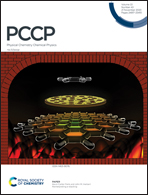On the ligand-free palladium cluster catalysed Suzuki–Miyaura reaction†
Abstract
C–C cross coupling reactions have been widely used for developing synthesis protocols for pharmaceuticals and agricultural products in the past few decades. Of all the reported C–C cross coupling reactions, the Suzuki–Miyaura reaction is preferred because of its mild reaction conditions, the commercial availability of associated reagents and the ease of removal of boron containing by-products. Recently, Corma and co-workers [Leyva-Perez et al., Angew. Chem., 2013, 125, 11768] reported water-stabilized three- and four-atom Pd clusters as highly active catalytic species for C–C coupling reactions. The present work focuses on developing detailed mechanistic insights into the Suzuki–Miyaura reaction with Pd3 and Pd4 clusters utilizing density functional theory calculations. The role of the base in the reaction was analysed in this study, which was found to lower the activation barriers of transmetalation over both Pd3 and Pd4. Free energy landscapes for Suzuki–Miyaura coupling of bromobenzene and phenylboronic acid over Pd3 and Pd4 clusters were developed. The highest free energy barriers of 34.7 and 30.4 kcal mol−1 were observed for the oxidative addition over Pd3 and Pd4, respectively, indicating the oxidative addition as the rate limiting step. Detailed energetics conclusively proved the active nature of small-atom Pd clusters for catalyzing the Suzuki–Miyaura reaction.



 Please wait while we load your content...
Please wait while we load your content...